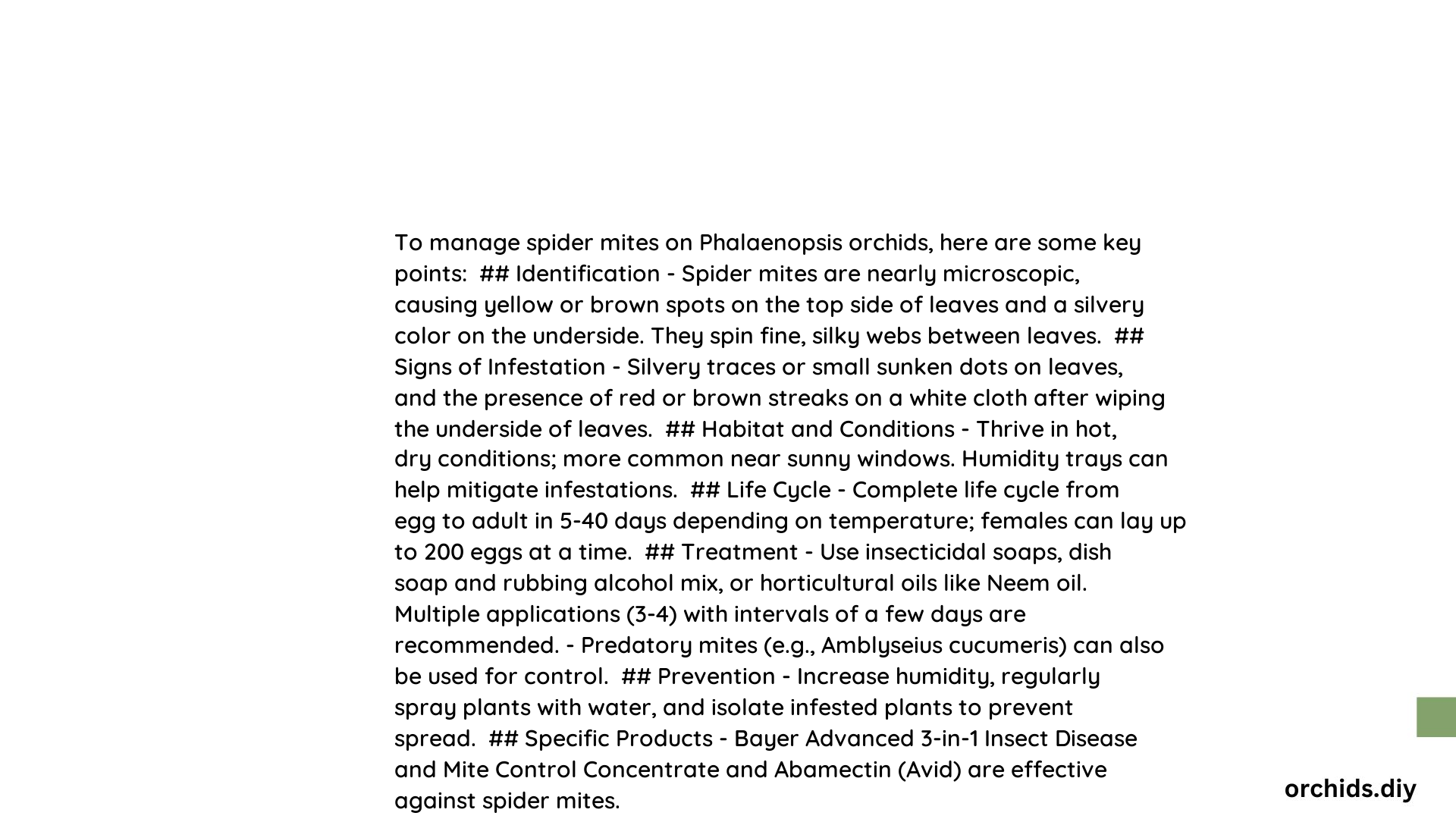Phalaenopsis spider mites are tiny arachnids that pose a significant threat to orchid health. These pests, barely visible to the naked eye, feed on plant cells, causing damage to leaves and potentially leading to plant death if left unchecked. Spider mites thrive in warm, dry conditions and can rapidly reproduce, making early detection and prompt treatment crucial for orchid enthusiasts and growers. This article delves into the lifecycle, symptoms, treatment options, and prevention strategies for managing phalaenopsis spider mites effectively.
What Are the Lifecycle Stages of Phalaenopsis Spider Mites?
Spider mites on Phalaenopsis orchids progress through four distinct stages:
- Egg: Females lay eggs on leaf undersides.
- Larva: Three-legged stage, begins feeding on plant sap.
- Nymph: Four-legged stage, continues feeding and molting.
- Adult: Fully developed, reproduces and feeds on plant cells.
The entire lifecycle can complete in as little as 5 days at 75°F or up to 40 days at 55°F, depending on environmental conditions.
How Can You Identify Spider Mite Damage on Phalaenopsis Orchids?

Recognizing spider mite damage early is crucial for effective management. Look for these symptoms:
- Yellowing or browning of leaves
- Stippling or mottling (small white or yellow spots)
- Fine, silky webbing on leaf undersides
- Silvery sheen on upper leaf surfaces
- Leaf distortion or curling
- Premature leaf drop in severe cases
What Are the Most Effective Treatment Options for Spider Mites?
Chemical Solutions:
- Miticides:
- Products like Avid
- Apply according to label instructions
-
Typically 3 applications at 4-day intervals
-
Soap and Oil Mixtures:
- 1 part rubbing alcohol + 1 part 409 or Murphy’s Oil Soap + 2 parts water
- 2% oil solution (baby oil or vegetable oil) in water with dish detergent
Organic Solutions:
- Insecticidal Soap:
- Safer alternative
-
Multiple applications required
-
Predatory Mites:
- Amblyseius cucumeris
-
Avoid concurrent insecticide use
-
Neem Oil:
- Part of integrated pest management
- Effective against various stages of mites
How Often Should Treatments Be Applied?
For optimal control:
- Spray treatments once a week
- Continue for at least three weeks
- Ensures targeting of all lifecycle stages
What Are the Potential Costs and Recommended Products?
| Product Type | Recommended Brand | Approximate Cost Range |
|---|---|---|
| Miticide | Avid | $50 – $100 |
| Insecticidal Soap | Safer’s Soap | $10 – $20 |
| Neem Oil | Bonide Neem Oil | $15 – $30 |
| Predatory Mites | Amblyseius cucumeris | $30 – $60 per 1000 mites |
How Can You Prevent Spider Mite Infestations?
Environmental Control:
- Maintain high humidity levels
- Keep temperatures below 75°F when possible
- Ensure good air circulation
Cultural Practices:
- Regular leaf spraying to maintain moisture
- Consistent watering schedule
- Proper plant spacing for air flow
Monitoring Techniques:
- Regular inspections of leaf undersides
- Use of white cloth test for mite detection
Are Certain Phalaenopsis Varieties More Susceptible to Spider Mites?
While specific resistant cultivars are not well-documented, some general traits influence susceptibility:
- Thin-leaved orchids are more vulnerable
- Proper care enhances overall plant resistance
To improve resilience:
- Maintain optimal humidity
- Provide adequate light
- Follow proper watering practices
- Ensure balanced nutrition
What Are the Long-term Effects of Spider Mite Infestations on Phalaenopsis Orchids?
Untreated infestations can lead to:
- Reduced photosynthesis
- Stunted growth
- Weakened immune response
- Increased susceptibility to other pests and diseases
- Plant death in severe cases
Early detection and prompt treatment are crucial for minimizing long-term damage and preserving plant health.
